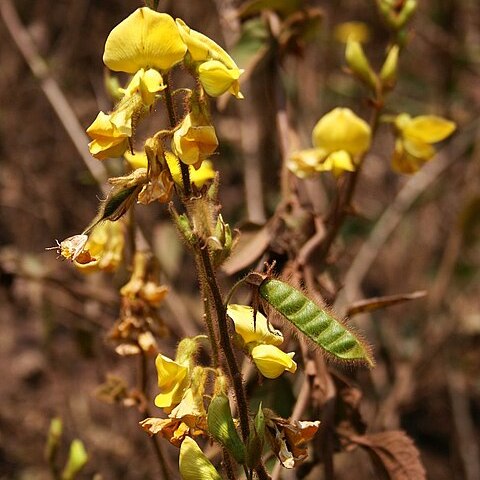Vines, woody, twining, to several meters tall, yellow-brown villous except for corolla. Stems densely hairy when young, later glabrescent, to dark brown. Leaves pinnately 3-foliolate; stipules ovate-lanceolate, 7-12 mm, persistent; petiole 3-7 cm; terminal leaflet ovate to ovate-elliptic, 5-10 × 3-5.5 cm, densely villous when young, later glabrescent, base rounded, apex acuminate with hard mucro. Peduncle a few centimeters; bracts ovate, densely villous. Flowers ca. 3 cm; pedicels slender, 11-15 mm. Calyx campanulate; lobes linear-lanceolate, lowest longest, ca. 2 × as long as tube. Corolla yellow; standard obovate-elliptic, ca. 2.8 cm, base with an inflexed auricle on each side, apex slightly emarginate; wings broadly elliptic, base with auricle on one side; keels sickleform, slightly shorter than wings, clawed, without auricle. Ovary linear, densely villous; style long, curved, glabrous; stigma capitate. Legume long elliptic, 4-6 × ca. 1 cm, straight, densely villous, apex beaked. Seeds 5-7, brown, subspherical, ca. 4 mm in diam., wider than long; strophiole acute and white, succulent. Fl. Jan-Feb, fr. Feb-Jul.
More
A bean. It is a woody twining vine. It can grow several metres tall. The young stems are hairy. The leaves have 3 leaflets. The leaf stalk is 3-7 cm long. The end leaflet is oval and 5-10 cm long by 4-5 cm wide. The base is rounded and they taper to the tip. The flowers are about 3 cm across. The pod is 4-6 cm long by 1 cm wide. It is straight and hairy. There are 5-7 brown seeds.
It is a tropical plant. In southern China it grows between 1,000-1,300 m above sea level. In Yunnan.

